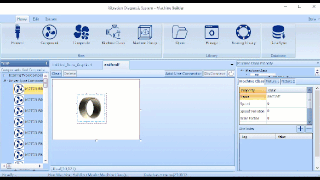VDS Machine Builder
The Vibration Diagnostic System (VDS) software provides several important tools for machine predictive maintenance data collection, analysis and management. When synchronized with a CoCo handheld analyzer, the system integrates factory and route structuring, machine information, vibration data and analysis all in one place. The diagnostic algorithms are based on the concept of a machine model, and VDS provides a powerful tool for building machine models. This tool is called the Machine Builder.
Machine Builder is a tool within the VDS software that allows users to construct a model of a machine using a graphical interface. This machine model provides crucial information to the automated diagnostic system to assist in the machine’s diagnosis. The information provided by the machine model includes machine characteristics such as forcing frequencies, pickup locations and bearing metrics. These characteristics are passed to the diagnostic system and used along with the rules to produce a diagnosis of the machine’s health.
Figure 1: Machine Builder Home Toolbar
Machine builder uses a system of discrete parts. These parts begin at the most fundamental piece known as an element and work to larger parts known as components. Two or more components produces the final product known as the machine class.
Machine Class
A machine class defines a type of machine. Examples include water pumps, cooling fans, A/C compressors, etc. Users can base machines in the database on a machine class. Machines that are based in the same machine class are considered as the same type of machine. Everything about them should be the same. The same motor, same bearings, same number of pump vanes, etc.
Build Machines
Machine Builder allows users to model their machinery with reusable machine components. Just drag and drop components and composites from the left pane into the workspace to build a machine train. Complex gear boxes can be modeled. Machine Builder will query the user for physical information about their machine.
Figure 2: Machine Builder workspace
Forcing Frequency
The “Forcing Frequency” is also known as a forcing order. This is the fundamental characteristic for any element on a rotating shaft. Forcing frequencies are typically integer numbers and consist of the number of items within the rotating element. Examples include the number of fan blades, motor bars, pump vanes, gear teeth (gear mesh), etc.
The Component Detail window allows the user to:
Choose the orientation of the component
Designate one component as the speed component, which will be associated with the default shaft
Add or remove forcing frequencies that are common to the component on the machine
Enter attribute information
Show the component pickup state
Pickup Points
Pickup Points are the location where data will be collected. For data collectors, data will always be collected over bearing housings. Pickup points are flexible enough to be placed anywhere on the machine to allow for Process Points.
Assign Machines to Machine Classes
When a new machine is added to the database the user can assign it a machine class. This enables automatic analysis on the machine. Users do not have to assign machines to a machine class.




